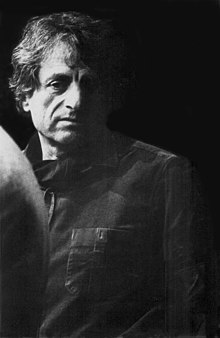Oophaa
| Oophaa | |
|---|---|
| Chamber music by Iannis Xenakis | |
 Iannis Xenakis in 1975 | |
| Composed | 1989 |
| Performed | 17 September 1989: Warsaw |
| Published | 1989: Paris |
| Scoring | Amplified harpsichord and percussion |
Oophaa is a composition for amplified harpsichord and percussion by Iannis Xenakis, finished in 1989.
Background
Oophaa was composed shortly after finishing
Structure
Oophaa is in one movement and has a total duration of about nine minutes. The piece has a total length of 81 bars and starts with a tempo marking of 60
Despite being the last harpsichord piece composed by Xenakis,[1] it is one of his least challenging pieces for harpsichord: it is one of the pieces for chamber ensemble with the least polyrhythmic structures (only six 3:4 polyrhythmic cells can be found on the percussion side), the rhythm is practically steady through the whole piece (with tempo changes) and the harpsichordist part only includes chords.[7] As in Komboï, the different chords and percussion combination of simultaneous sounds are meant to complement each other, creating sound saturation and complex, superimposed rhythmic material.[7]
The piece also features several solo passages, both for the harpsichord and the percussion.[2] The percussionist is also asked to play some skin-instrument fragments both with his hands and mallets. A practice that was commonplace among many of Xenakis's works, Oophaa was written as a manuscript with little regard to how the music would be performed in terms of practicality. This caused harpsichordist and frequent collaborator Elisabeth Chojnacka to state that, in order to play the piece, one should have "exceptionally" large hands, and the most common way to play the piece would be for the performer to either divide some chords and play them with both hands or rewrite the chords altogether.[6] Chojnacka also stated that, upon tackling the piece, she chose not to take into account the many changes of register indicated in the score, and that the harpsichordist should feel free to take inspiration from them when attempting to play the piece, as a choice should be made by the performer whether to play them or not, given the extraordinary difficulty of Xenakis's output.[6]
Reception
Oophaa has not garnered much attention since its publication, probably because it is less technically demanding than the other harpsichord pieces and the structure is much simpler and devoid of dramatic construction. Critic
Recordings
Recordings of Oophaa are rare. Following is a list of notable recordings of the piece:
- The musicians who premiered the piece, Sylvio Gualda and Elisabeth Chojnacka recorded the piece in 1990 in Radio France under the label Accord. This recording was produced by Alain de Chambure, with sound engineer Myron Meerson.[8]
- Percussionist Pleyel harpsichord was used for this recording.[9]
References
- ^ a b c Harley, James. "Oophaa, for harpsichord &… | Details". AllMusic. Retrieved 29 May 2021.
- ^ ISBN 978-1-135-87495-7. Retrieved 29 May 2021.
- ^ a b Skouras, Andreas (2011). The harpsichord works of Iannis Xenakis: Ultimate challenge in a neglected repertoire (PDF). Munich: University of Music and Performing Arts. Retrieved 29 May 2021.
- ^ Solomos, Makis (2008). "Notes sur Elisabeth Chojnacka et les œuvres pour clavecin de Xenakis". Hommages (2): 51–58. Retrieved 29 May 2021.
- ^ a b "Oophaa – Iannis Xenakis" (in French). Retrieved 29 May 2021.
- ^ a b c d e f g Xenakis, Iannis. Oophaa: clavecin et percussion. Salabert. Retrieved 29 May 2021.
- ^ a b c Silva Pereira, Lucio (2014). Particularidades da percussão múltipla na música solo e de câmara mista de Iannis Xenakis (PDF). Goiânia: Universidade Federal de Goiás. Retrieved 29 May 2021.
- ^ Liner notes of Accord 205652. Accord. 1996.
- ^ Schick, Steven (2006). Liner notes of Mode 171/73: Xenakis - Percussion Works. New York: Mode Records.
